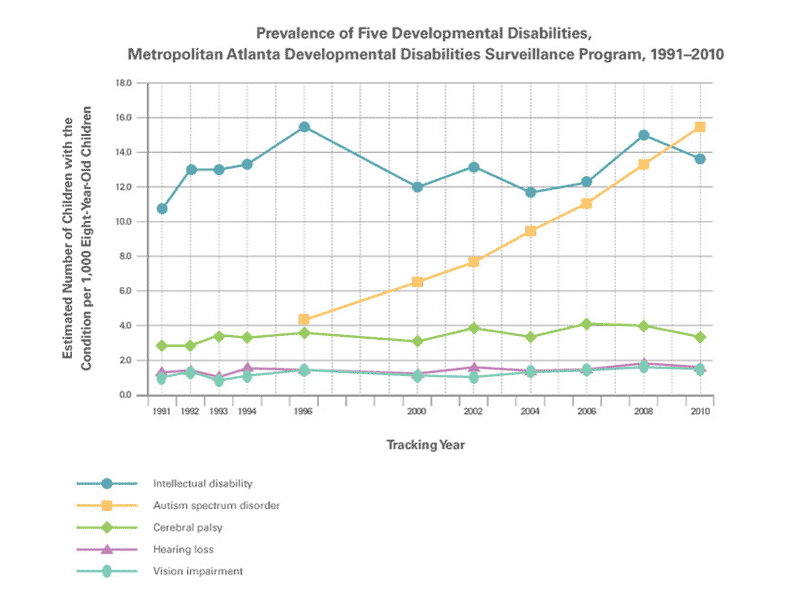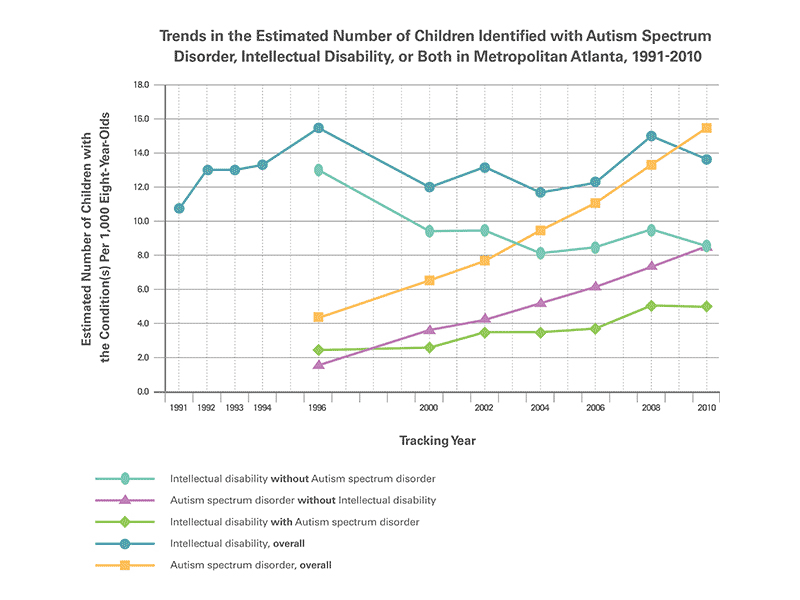Key Findings: Trends in the Prevalence of Autism Spectrum Disorder, Cerebral Palsy, Hearing Loss, Intellectual Disability, and Vision Impairment, Metropolitan Atlanta, 1991-2010
PLoS One has published a new study looking at trends in the prevalence and characteristics of children identified with developmental disabilities in metropolitan Atlanta. Researchers found that estimates of the prevalence of children with cerebral palsy, hearing loss, intellectual disability, and vision impairment have remained about the same over the past 15-20 years. In contrast, they found a large increase over time in estimates of the prevalence of children with autism spectrum disorder. These findings may signal a need for increasing community services (such as healthcare services, early intervention programs, special education services, and others) to support children with developmental disabilities and their families.
You can read the full article here. Read more below for a summary of findings from this article.

Main Findings:
- From 1991-2010, the estimated prevalence of intellectual disability (ID) and hearing loss (HL) among 8-year-old children in metropolitan Atlanta remained about the same with a slight increase in vision impairment (VI). The estimated prevalence of cerebral palsy (CP) among 8-year-old children remained the same from 1993-2010.
- In contrast, the estimated prevalence of autism spectrum disorder (ASD) among 8-year-old children in metropolitan Atlanta increased 269% from 1996 -2010, an average of approximately 9% each year.
- Increases over time were found among both boys and girls and among nearly all racial/ethnic groups.
- Increases over time were also found among children with ASD who also had ID, as well as among those without ID. In contrast, the estimated prevalence of ID without ASD was stable.
- These findings may signal a need for community services (such as healthcare services, early intervention programs, special education services, and others) to provide ongoing support for children with ID (1 in 77), CP (1 in 286), HL (1 in 714) and VI (1 in 769), with a potential need for growth of these services to support the increasing number of children identified with ASD by 2010 (1 in 64).
- Public health professionals, healthcare providers, educators, and researchers can use this information to help plan for service and training needs and guide future research into causes and factors that might increase or decrease the risk for these conditions.

About This Study
This study analyzed data collected by the Metropolitan Atlanta Developmental Disabilities Surveillance Program. Specifically, the study examined the prevalence and characteristics of children with ASD, CP, HL, ID, and VI over a 15-20 year time period. Special focus was put on looking for changes in the prevalence of children with ASD and ID over time. This study adds to the limited information on trends in the prevalence of children with developmental disabilities. It is unique in that it looked at changes in the prevalence of children with ASD by level of intellectual ability, both overall and within different racial/ethnic groups, as well as trends in the estimated prevalence of children with ID, CP, HL and VI, in the same diverse population.
More Information
- To learn more about autism spectrum disorder, please visit www.cdc.gov/autism
- To learn more about the Metropolitan Atlanta Developmental Disabilities Surveillance Program, please visit www.cdc.gov/MADDSP
- To download free resources that can help parents, healthcare providers, and early childhood care and education providers track each child’s development, please visit www.cdc.gov/ActEarly
Key Findings Reference
Van Naarden Braun K, Christensen D, Doernberg N, Schieve L, Rice C, Wiggins L, Schendel D, Yeargin-Allsopp M. Trends in the Prevalence of Autism Spectrum Disorder, Cerebral Palsy, Hearing Loss, Intellectual Disability, and Vision Impairment, Metropolitan Atlanta, 1991-2010. PLoS One. 2015;10(4).
Glossary:
Prevalence — The proportion or percentage of people with a condition or disease out of the total number of people in the population. In this study, the prevalence for each of the developmental disability conditions was the number of 8-year-old children with each developmental disability in metropolitan Atlanta in each year of measurement divided by the corresponding total number of 8-year-old children in metropolitan Atlanta.
- Page last reviewed: May 29, 2015
- Page last updated: May 29, 2015
- Content source:


 ShareCompartir
ShareCompartir